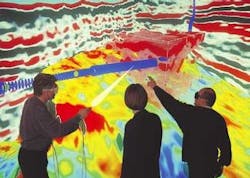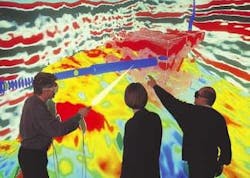Real-time data delivery evolving into informed execution
Enabling technologies converge in intelligent fields
Ian Bryant
Schlumberger
The automated oilfield, once a novel idea and vision for the future of the energy industry, has reached a point in its growth that is spurring an even greater revelation – the intelligent oilfield. In the intelligent oilfield, there will exist the ability to monitor and control all of the key processes within a reservoir as they take place, and respond optimally and rapidly to changing conditions. Furthermore, the opportunity to decrease manning levels on platforms and drilling rigs will result in reduced risk exposure.
No longer a remote possibility, intelligent components continue to prove their reliability and value in both traditional and more complex completions. The intelligent oilfield is coming of age quickly and quietly, and because of enabling technologies produced in the past seven years, there now exists the ability to not only monitor, but control well systems and production in real-time.
The next milestone in development will involve establishing a tremendous level of efficiency in conditioning data streams and integrating all disciplines to manage the reservoir according to a new definition of real time – making and leveraging the right decisions within the most efficient business workflow. Decisions are better because they occur earlier in the process and are based on more complete knowledge. Such ability translates into earlier production and better allocation of capital and expenditures budgets.
Genealogy of the intelligent field
null
Operators have used permanent downhole pressure gauges since the 1960s. During a proliferation of such installations, Schlum-berger first installed a permanent downhole gauge in West Africa in 1973. In 1975, a pressure and temperature transmitter was installed on a single wireline cable. After that, milestones included subsea installations in the North Sea and offshore West Africa, a subsea installation with acoustic data transmission to surface, and in 1986, a fully welded metal tubing-encased permanent downhole cable and the introduction of a quartz crystal gauge.
null
A significant increase in the use of permanent installations occurred after more reliable gauges, incorporating quartz and sapphire crystals, were developed in the early 1990s. In 1994, an accreditation program substantiated the reliability of permanent quartz gauges. Schlumberger's FloWatcher integrated permanent production monitoring system was installed to measure mass flow rate downhole, and long-term laboratory testing of permanent components also began.
Complete well site production monitoring and communications equipment, such as Schlumberger's WellWatcher system, now handles diverse sensors that measure mass flow rate and fluid density, monitor electric submersible pumps, and measure pressure and temperature. Surface sensors measure multiphase flow rate together with pressure and can detect sand production. Valves and chokes are also controlled from the surface. Measure-ments or data are transmitted from downhole devices through cable to the surface.
Permanent reservoir monitoring, vital to intelligent completions, created the next phase of intelligent field evolution. Some pressure gauges are sampled at 1-sec frequencies, while other types of sensors are sampled less frequently. Those installations in which measurements are taken every second of the day may produce over 31 million data points per year.
Wisdom infrastructure
In the beginning, the challenge centered on obtaining and understanding data received from downhole gauges. Now the volumes of data must be managed and reduced into information that can be integrated with a focus on generating value. Value is achieved when the right information is provided to the right person at the right time, and the ability exists to act optimally on that information.
This has been the area of focus during the past decade – developing information technology, optimizing workflows, and taking an integrated, multidisciplinary solutions approach to propel the industry toward the day when common, everyday functions will be run much like a refinery, and talent remains focused on development and reservoir concerns. The dynamics of multidisciplinary technology collaboration between client and service provider can add value at every phase of development. Current and potential progress made in the area of IT solutions adds value from exploration to abandonment, confirming the benefits that beckoned the industry to set forth on this quest to create the intelligent field in the first place.
The industry has been searching for business benefits such as daily operations improvements and better long-term reservoir management, early diagnosis of problems, fewer well interventions, reduced risk, and greater reserve recovery. A fully automated platform can save the operator about 45% on capital expenditures and offer the producer a 72% reduction in topside equipment.
Has the "holy grail," a system guided by digital control processes and rapid decision-making, been found? Just working toward achieving the goal of the intelligent field is revolutionizing energy production practices, ushering in a new era in which worldwide recovery rates will be increased. And it will take fewer smart wells than conventional wells to achieve this increase. There remains huge added value to be gained when we're able to react instantly and optimally to unexpected changes in the overall system.
Rather than adopting technologies, including workflows and processes that address specific needs, emerging technologies are now driving the evolution process, producing a spiral-like effect where improvements in one area benefit and effect change in another.
First, the industry responded to a vision of an intelligent field by investing in the development of enhanced sensors, valves, and communication capabilities. Next came the data explosion, and it became clear that advanced methods and software systems (currently being developed) would prove critical to exploit new measurement technology.
Value from real-time processes
The current challenge lies in how to apply the latest network and infrastructure technologies, to manage and integrate the diverse sources of data, to interface with fragmented legacy systems, and to collaborate with operating companies in developing the workflows of the future. Digital data streams being fed through a secure network have the potential to result in big savings.
Transmitted via offshore microwave systems, satellites, or leased land lines, the incoming volume of data is conditioned to remove interference resulting from anomalous data. Then, using proprietary software, it is processed into appropriate formats, and authority for different access levels set.
Threshold alarms are set to send automatic email, pager, or phone notifications of events according to different levels of urgency defined by the user via a Web interface, notifying relevant parties of events in the well as they take place. Such capability allows operators to discern where and when immediate action is needed. For instance, the operator may dispatch a service unit immediately once a well's production drops below a threshold, rather than wait until the service unit makes its regularly scheduled stop. Certainly, the ability to take immediate action when required is invaluable.
Leveraging industry leading Web portal technology, Schlumberger's DecisionPoint information management solution is built on an integration framework designed expressly for the upstream oil and gas industry to screen pertinent data, flag under-performing wells, diagnose production problems, and recommend corrective actions to optimize field production. Through a digital dashboard that provides convenient Web access to monitor and manage key performance indicators, the system brings work processes, applications, and information together in one convenient location.
Accessibility is even customized to offer varying levels of input. Just as current stock information is automatically posted to a user home page, well data is made available. Based on the user's role, immediate, personalized access to work process information and tools in key areas of structured data, unstructured data, and work process tools is provided.
Another enabling service exists in the DecisionXpress information management solution, a platform that provides a highly integrated, quality-controlled petrophysical interpretation within minutes after completion of actual logging operations.
A test of reality
As a consequence of enabling IT and fiber-optic technologies that have emerged during the past seven years, the mid-1990s vision – to monitor and control in real time all of the key processes that go on within a reservoir – is now realized in several test wells. In spring 2002, attendees at the Offshore Technology Conference in Houston witnessed a significant real-world experiment.
The Schlumberger RES2000 research well used a horizontal well producing oil from a thin oil reservoir with a three-zone openhole completion. The completion, in an area of Indiana known as "the Pocket," employed deep reading sensing with remote monitoring and flow control of each zone to dynamically manage production in real-time – from anywhere in the world. A gravel pack completion was chosen to demonstrate the system's ability to aid in managing fluid entry across lengthy horizontal sections as found in many subsea wells. A fiber-optic, real-time distributed temperature sensing system also was installed. The data was delivered anywhere in the world through a secure network environment.
Two points were critical to this successful demonstration: the well had to be drilled in the right place to give preferred drainage, and a reliable system of monitoring and control was required to manage the production in real time. The InterACT wellsite monitoring system, in combination with the GeoVision resistivity tool, was used to drill the pilot hole and horizontal section of the well.
For this project, the InterACT system provides Web-based data delivery with secure, real-time two-way communication that makes data and information available at all stages of the exploration, development, and production cycle. Using mud pulse telemetry, the GeoVision tool transmits images from the drill string to the surface. Logging-while-drilling logs, transmitted for the first time from the well site to experts in Connecticut and England, allowed accurate placement of the well into the thin oil column.
Electrically operated wireline retrievable flow control valves are used to control flow into the wellbore. The five data acquisition systems in operation at the site generate around 200 MB of data per day; the data are preprocessed at the well site and then transferred to a separate location for backup and analysis. Real-time data can be accessed on a laptop or handheld computer or even via a cell phone.
What's next?
One company is working on a robot that crawls into the well to perform maintenance tasks. And microseismicity is being used as a means to monitor fracture growth to add value by monitoring hydraulic fracture stimulations as they are pumped. Two-phase downhole production monitoring is delivering real-time production data.
While further developments may help us reach our goals, the industry will only achieve the greater vision of the truly intelligent oilfield when capabilities in real-time management are realized and we are able to provide accurate information to the right person within the appropriate time frame, allowing optimal action to result from the incoming information.
While headlines have heralded the technology and expertise used to explore and understand planets such as Mars and Saturn, similar efforts are underway to harness the energy potential of Earth. The enabling upstream tools and technology will converge with reinvented workflows, and platforms like Mars and Neptune will be connected to a truly intelligent oilfield complete with remote reservoir and production management, control, and execution.
The oil industry has been characterized by an ingrained conservatism. Yet, with the passage of time and the need for increased efficiencies, operators will clamor for an intelligent oilfield as opposed to automated fields. Decisions, the key component in the intelligent oilfield, will be based on information provided within the actual timescale of business workflow.
The truly intelligent field will possess the ability to learn from and adapt to changing conditions and new data. Proactive rather than reactive field management will be the byword of the day.

